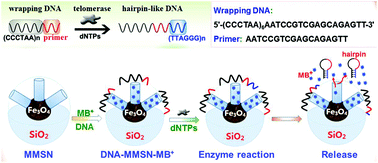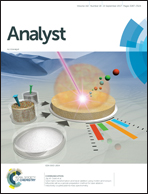Bioresponsive-controlled release of methylene blue from magnetic mesoporous silica from the electrochemical detection of telomerase activity
Abstract
An electrochemical sensing platform was designed to monitor telomerase activity in HeLa cells, using bioresponsively controlled cargo release from magnetic mesoporous silica nanocontainers (MMSNs). The aminated MMSNs were first synthesized by a wet-chemistry method, then methylene blue (indicator) molecules were loaded into the pores with the aid of specifically designed wrapping DNA strands, and then the wrapping DNA-gated MMSNs were immobilized on a magnetic removable screen-printing carbon electrode. Upon target telomerase and dNTP introduction into the detection cell, the wrapping DNA strands on the MMSNs were prolonged to form rigid hairpin-like DNA structures, thus resulting in the dissociation of wrapping DNA strands from the MMSNs. Thereafter, the loaded methylene blue with redox activity was released out from the pores, thereby causing the increase in the electrochemical signal relative to the background signal. Under optimal conditions, an MMSN-based sensing system exhibited good voltammetric responses toward target telomerase activity within the dynamic linear range of 50–5000 cells per mL at a detection limit of 12 cells per mL in the HeLa extract. The reproducibility and generality of our strategy were acceptable by using somatic tumor cell lines. In addition, the inhibition effect of this system was also evaluated by using 3′-azido-3′-deoxythymidine as a telomerase inhibitor, receiving good results in this screening research.



 Please wait while we load your content...
Please wait while we load your content...